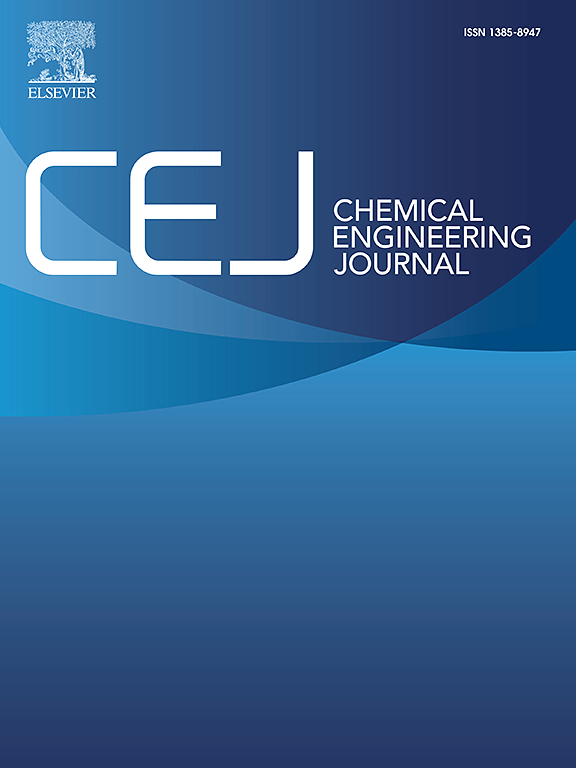Efficient removal of Cu2+ on Medulla Tetrapanacis-based modified biochar: adsorption performance, mechanisms and recycling for fabrication of supercapacitor electrodes
IF 13.2
1区 工程技术
Q1 ENGINEERING, CHEMICAL
引用次数: 0
Abstract
Achieving high-capacity removal of Cu2+ from effluent remains challenging nowadays. Hence, high-performance calcium chloride modified Medulla Tetrapanacis based biochar (MBC) was prepared by simple impregnation treatment and tube furnace carbonization. The results of sorption experiments confirmed that the MBC obtained at 900 °C (MBC3) possessed the highest sorption under specific conditions (pH = 6 at 0.2 g/L). MBC3 showed the highest fitting to the pseudo-second kinetic model and the Langmuir model (R2 = 0.996, 0.947). The fitted MBC3 achieved the maximum adsorption of Cu2+ of 945.6 mg/g, being 2.25 times higher than the adsorption of unmodified biochar (BC). Multiple mechanisms including precipitation, ion exchange and surface complexation were evidenced to be associated with the excellent sorption properties of MBC3. Considering the potential hazards of enriched Cu, MBC3 after sorption was reused as ReBC/Cu for preparing supercapacitor electrodes through a facile hydrothermal method (180 °C, 24 h). The adsorbed Cu elements were found to be mainly loaded as oxides in ReBC/Cu. It was calculated that the ReBC/Cu electrode displayed a specific capacitance of 142.5 F/g at 0.5 A/g, which was 49.01 % enhancement compared to that of the unused pristine biochar. This study combines biochar-based adsorption with the preparation of supercapacitor electrodes, which not only achieves efficient copper removal from water, but also provides a promising option for the post-treatment of copper-rich waste adsorbents.

四根髓基改性生物炭对Cu2+的高效去除:吸附性能、机理及超级电容器电极的回收利用
目前,从废水中实现高容量去除Cu2+仍然具有挑战性。为此,采用简单浸渍法和管式炉炭化法制备了高性能的氯化钙改性四足髓生物炭。吸附实验结果证实,在特定条件下(pH = 6,0.2 g/L),在900 °C时得到的MBC (MBC3)具有最高的吸附性。MBC3对拟秒动力学模型和Langmuir模型拟合度最高(R2 = 0.996,0.947)。MBC3对Cu2+的最大吸附量为945.6 mg/g,比未改性生物炭(BC)的吸附量高2.25倍。沉淀、离子交换和表面络合等多种机制与MBC3优异的吸附性能有关。考虑到富集Cu的潜在危害,吸附后的MBC3再利用为ReBC/Cu,采用水热法(180 °C, 24 h)制备超级电容器电极。在ReBC/Cu中,Cu元素主要以氧化物的形式被吸附。计算结果表明,在0.5 a /g下,ReBC/Cu电极的比电容为142.5 F/g,比未使用的原始生物炭提高了49.01 %。本研究将生物炭基吸附与超级电容器电极的制备相结合,不仅实现了水中高效除铜,而且为富铜废物吸附剂的后处理提供了一种有前景的选择。
本文章由计算机程序翻译,如有差异,请以英文原文为准。
求助全文
约1分钟内获得全文
求助全文
来源期刊

Chemical Engineering Journal
工程技术-工程:化工
CiteScore
21.70
自引率
9.30%
发文量
6781
审稿时长
2.4 months
期刊介绍:
The Chemical Engineering Journal is an international research journal that invites contributions of original and novel fundamental research. It aims to provide an international platform for presenting original fundamental research, interpretative reviews, and discussions on new developments in chemical engineering. The journal welcomes papers that describe novel theory and its practical application, as well as those that demonstrate the transfer of techniques from other disciplines. It also welcomes reports on carefully conducted experimental work that is soundly interpreted. The main focus of the journal is on original and rigorous research results that have broad significance. The Catalysis section within the Chemical Engineering Journal focuses specifically on Experimental and Theoretical studies in the fields of heterogeneous catalysis, molecular catalysis, and biocatalysis. These studies have industrial impact on various sectors such as chemicals, energy, materials, foods, healthcare, and environmental protection.
 求助内容:
求助内容: 应助结果提醒方式:
应助结果提醒方式:


